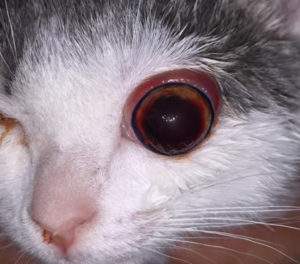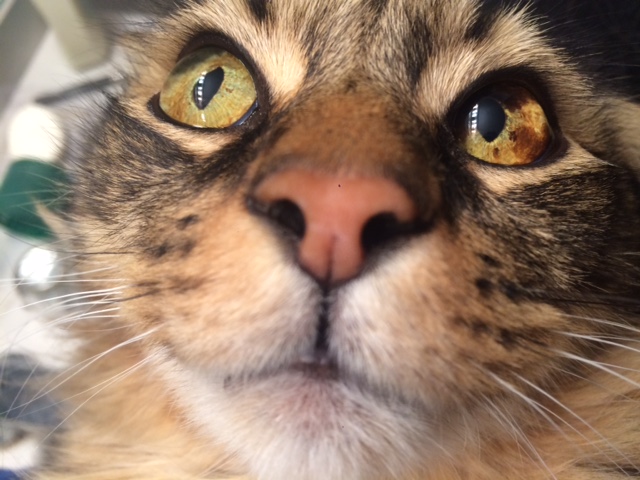sarcoma in cats eye
Tumor of the eye in cats is a general term that can refer to a large variety of malignant cancerous or benign non-cancerous tumors or growths in various areas of the eye of your cat. Some cancers can spread very quickly so its important to educate yourself about the symptoms of cat tumors.
Fibrosarcoma Soft Tissue Sarcoma.

. A cat tumor can create a number of symptoms in your cat. How is it treated. If your cats imaging studies suggest that the tumor may be a meningioma a benign tumor of the brains external lining your veterinarian may recommend surgical removal because this treatment is often curative.
Surgical removal needs to be wide and deep as. 2 Macrophages represent the lineage involved with the hemophagocytic syndrome. As the primary tumor gets larger and begins to stretch the overlying skin and invade underlying tissues skin ulceration pain persistent bleeding infection and necrosis negatively affect the cats quality of life as seen in Figure 5.
It is a mass that usually occurs in the skin of a cat at the site of an injection or vaccination. Surgical removal is the best option for several different types of brain tumors. Chemotherapy may be.
The most common types of tumors of the eye in cats are called melanocytic eye tumors which can progress to uveal melanoma. Secondly a feline sarcoma can also arise from a virus. Histiocytic diseases in cats and dogs derive from either dendritic or macrophage lineage.
Because of this fibrosarcomas are also referred to as injection site sarcomas or vaccine associated fibrosarcomas. Post-vaccination sarcomas usually involve the fibrous connective tissue under the skin and are often fibrosarcomas. Some of them include liposarcoma fibrosarcoma spindle cell tumors and hemangiopericytomas.
Higher doses have been somewhat successful. There are different forms of sarcoma that develop in cats. Affected cats often have a history of penetrating ocular injury resulting in the perforation of the lens but trauma is not necessary.
It is a mesenchymal tumor in which the fibroblasts of the connective tissue proliferate. Ophthalmic examination revealed upper and lower eyelid entropion of the left eye OS and markedly decreased retropulsion restricted eye movement marked episcleral congestion and severe ke. Melanoma of the Iris.
The Vaccine-Associated Feline Sarcoma Task Force is an alliance of veterinary organizations dedicated to studying and remedying this problem. A 16-year-old spayed female cat was evaluated for lagophthalmos and chronic exposure keratitis in both eyes. Limbal melanomas are benign non-cancerous and less common than iris melanomas.
Limbal melanomas develop from the melanocytes found at the limbus the border of the cornea transparent front part of the eye and the sclera white part of the eye. There are two major root causes. This is a cancerous growth presenting as a mass on the body or leg of a cat.
Soft tissue sarcoma refer to a broad group of tumors that originate from connective tissues. Its important to know that the risk of not vaccinating your cat far outweighs the possibility of her developing a vaccine-associated sarcoma. The majority of canine histiocytic sarcomas HSs arise from interstitial DCs.
Feline ocular sarcomas are malignant intraocular neoplasms that are often associated with a history of ocular trauma. A fibrosarcoma is a type of cancerous tumor that occasionally occurs in cats. Surgery is the mainstay of treatment for injection-site sarcoma.
Eyelid and conjunctival tumors are the most frequent primary eye tumors. Firstly it is a vaccine-associated sarcoma meaning it can appear after a vaccine. Unlike other cancers however nasal tumors do not tend to metastasize to distant sites.
A tumor that develops at the site of a vaccine injection such as for rabies or. Radiation therapy may be performed either before or after surgical removal of the tumor in order to. A veterinary pathologist can give the vet and cat owner a prognosis which gives the cat owner a probability of recurrence of the cancer or a metastasis.
A local vaccine-associated sarcoma is one that grows at the place where the feline receives a vaccination. One common predictor of local recurrence is completeness of the surgical excision ie clean margins. Spindle-cell sarcomas generally do not respond well to conventional doses of radiation.
Cancers and Tumors of the Eye in Cats Tumors of the Eyelid and Conjunctiva. 1 Dendritic cells DCs include interstitial DCs and intraepithelial DCs Langerhans cells. Nerve sheath tumor previously called neurofibrosarcoma schwannoma hemangiopericytoma Rhabdomyosarcoma.
Soft-tissue sarcomas comprise approximately 15. The term soft-tissue sarcoma encompasses a broad category of tumors that show up in a cats connective muscle or nervous tissues. Sarcomas that recur have a greater potential for invasion into deeper tissues and spread to other parts of the body.
Another type of ocular melanoma in cats is the limbal sometimes called epibulbar melanoma. They tend to have similar histologic appearance and biological behavior and can be either benign or malignant. Soft tissue sarcomas can arise in any part of the pets body but skin and subcutaneous tumors are the most commonly observed.
What You Can Do. Mesenchymal tissues include connective tissues such as skin and muscles bone cartilage peritoneum and blood vessels. It is a very aggressive neoplasm with a.
Such sarcomas are better known as Vaccine Associated Sarcomas. Later surgeries for recurrent tumors may not increase the longterm survival of the cat. What Is a Fibrosarcoma in a Cat.
These cancers form from the fibroblasts cells that produce fibrous tissue and other supporting tissues most commonly arising beneath the skin. The degree of malignancy of these tumours varies some are highly. Cats appear to be the only species predisposed to the development of this neoplasia and the mean age is 12 years.
Melanoma occurs when melanocytes or darkly pigmented. The origin of the various. A sarcoma is a term for any cancer of mesenchymal tissues.
The most common primary tumor within the eyes of cats is widespread melanoma of the iris. Approximately 90 of nasal tumors are malignant meaning that they can spread. If the cat dies from fibrosarcoma it is likely because of the recurrence of primary site tumors.
They commonly present as gradually enlarging firm masses under the skin. The following are just four types of sarcomas in cats. Vaccine-associated sarcoma in cat associated with the injection site accounts for between 6 and 12 of feline tumors.
Nasal tumors are relatively uncommon in cats accounting for 1-5 of all feline cancers. Cats with cancerous tumors will show different symptoms depending on which part of the body is affected. Over the years research has been indicating that vaccines are associated with development of sarcomas in cats.
However these tumors can cause significant disease.

When To Take Your Cat To The Vet Cat Eye Infection Home Remedies Eye Infections

Tumor Of The Eye In Cats Petmd

Blood In The Front Of The Eye In Cats Petmd

A Very Tussi Face By Vanstaffs Beautiful Cats Gorgeous Cats Beautiful Cat

Globe Proptosis Feline Animal Eye Clinic

Common Eye Problems In Cats And Dogs Elite Veterinary Care

Feral Cat With Large Tumor On Jaw Makes Herself At Home On Family S Porch Baby Cats Animal Rescue Animal Rescue Site

Spina Bifida Endometriosis Sarcoma Military Deployment Etsy Cat Eye Bracelet Awareness Bracelet Awareness Jewelry

Diffuse Iris Melanoma In Cats Veterinary Vision Center

Cat No 5 The Right Eye Was Enucleated With A Histologic Diagnosis Of Download Scientific Diagram

Medicating And Pilling Cats How To Make It Easier Safer And Healthier For Your Cat Cat Care Cats Cool Pets

Diagnosis And Treatment Of Eyelid Tumors Today S Veterinary Practice

Feline Eye Conditions Learn What They Are Animal Eye Associates P A

Q A What Is This Brown Spot In My Pet S Eye Veterinary Revision

Cat Photos Outdoor In 2021 Cats Cat Photo Pets

Tumor In One Eye Affects Cat S Vision In Both Eyes Boston Herald

Clinical Image Of The Right Eye Of Cat 3 With Presumed Primary Download Scientific Diagram

